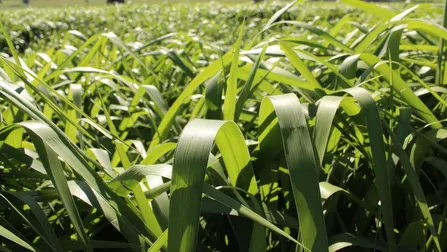
Indicação
É uma forrageira indicada para solos de média a baixa fertilidade, poucos profundos e também com cascalho. É uma ótima opção para regiões mais secas. Recomendado para bovinos nas fases de cria, recria e engorda, e também para equinos, ovinos e caprinos. Apresenta fácil manejo pelo porte menor, talos finos, folhagem intensa e ciclo mais longo.
Andropogon gayanus cv. MG7 Tupã
Certificado n° 20150084 até 08.12.2028
Média a baixa fertilidade
Pastejo direto
Até 2,60m
50 a 52%
Boa
Excelente
Resistente
Média a baixa
7 a 10 % na M.S.
16 a 20 t/ha/ano de M.S.
Perene
Utilização e Manejo
A MG7 Tupã é uma forrageira que pode ser utilizados em solos de fertilidade inferior, com problemas de profundidade e também com cascalho. É também indicada pra regiões de climas mais áridos, com menor índice pluviométrico. É recomendado para todas as fases de produção de carne e leite, além de equinos, caprinos e ovinos. O entrada de pastejo deve ocorrer quando as plantas atingirem 50 a 60 cm, e a saída na altura de 18 a 20 cm do solo.
Origem
Matsuda Genética. O trabalho de cruzamento de diversos acessos de Andropogon iniciou-se em 2004 (trata-se de uma população híbrida obtida pelo método de policross). Esses materiais vieram do germoplasma da Matsuda Genética. Em seguida o processo foi de seleção de plantas com características superiores desejáveis como a maior produção de forragem, melhor qualidade nutricional, porte mais baixo e plantas de ciclo mais tardio. Os testes de distinguibilidade, de homogeneidade e de estabilidade foram feitos em 2010 e 2011.
Características Morfológicas
Trata-se de uma gramínea tetraplóide de ciclo perene, forma touceira com vários perfilhos, planta de porte médio, colmo com 0,47 cm de diâmetro, folha com 90 cm de comprimento e 3,0 cm de largura, de 12 coloração verde e média pilosidade. O ciclo de florescimento é de aproximadamente 110 dias.
Características Agronômicas
A MG7 Tupã é uma planta forrageira para solos de média a baixa fertilidade, para solos poucos profundos e também com cascalho. É uma ótima opção para regiões mais secas. Recomendado para bovinos nas fases de cria, recria e engorda e também pode ser consumido pelos equinos. Essa cultivar apresenta fácil manejo pelo porte menor, talo mais fino, folhagem mais intensa e ciclo mais longo. O ciclo mais tardio faz com que a planta demore mais o seu florescimento, mantendo por mais tempo o seu ciclo vegetativo, ou seja, o período em que a planta mais cresce, mais produz forragem e mantém por mais tempo a qualidade nutricional.





